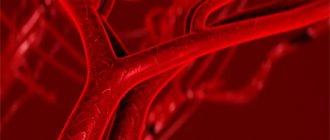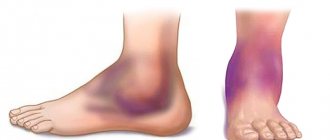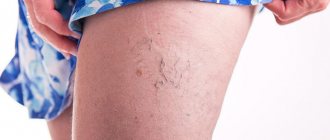Recently, a physiotherapeutic and cosmetic device – Darsonval – has gained great popularity. The use of such a device is quite highly effective and helps in the fight against many diseases.
Treatment occurs through exposure to pulsed alternating sinusoidal currents with a voltage of 20 kV and high frequency. In this case, the strength of each current flow is approximately 0.02 mA.
Currently, the device plays an important role in the treatment of blood vessel diseases, especially varicose veins.
Good alternative to surgery
Varicose veins are a chronic disease and require effective therapy to improve blood flow.
Usually the veins of the legs undergo pathology; in an advanced stage, this leads to severe stretching of the venous walls and stagnation of blood. It is very difficult to completely get rid of varicose veins; to treat such a disorder, a set of measures should be used. Surgical methods are widely popular, but patients often use alternative methods that can not only slow down the course of the disease, but also completely cure it. Darsonvalization is just the method that gives excellent results.
This technique primarily aims to improve the tone of vascular tissue. In addition, this device is actively used for preventive purposes.
Varicose veins: the price to pay for your lifestyle
“The disease of civilization” is a fashionable name now. In general, the term “disease of civilization” includes all diseases, the emergence, progression, and increase in the number of which is associated with the lifestyle of modern man. The diseases of civilization include myopia. arterial hypertension, flat feet, obesity, etc. The development of CVI in the vast majority of cases is associated with lifestyle, and therefore it is rightfully included in this group of diseases. I always like to make comparisons. Why, for example, did the primitive communal system not face the problem of varicose veins? Your whole life is on your feet: you must run a lot and quickly, a certain nutritional deficiency, respectively, low body weight, a relatively short life expectancy, the absence of a number of unfavorable environmental factors, such as a big city, ecology, etc. In addition. short stature, respectively, less pronounced gravity factor. Thus. Primitive people did not have problems with varicose veins on their legs. Modern man, on the contrary, is taller, sedentary, eats regularly and, as a rule, quite plentifully, moves either by car or in public transport, and mostly stands or sits at work. Plus, overall life expectancy has increased.
As a result, the number of people with vein problems has increased. Moreover, the forms of the disease themselves are modified. For example, when I was in college, that... what is now called the “hacker”, “geek” syndrome did not exist. Now this is a problem for relatively young people. they spend long hours on the computer and develop venous edema and other lifestyle-related signs of venous insufficiency. There is also the so-called “economy class syndrome,” or the syndrome of long trips on an airplane, traveling on a bus, or in a car. Due to prolonged immobility, the veins are poorly emptied of blood, the muscles are relaxed, dehydrated, plus the impact of unfavorable additional factors - and we get the same thing. Another factor is that hormonal contraception leads to hormone-induced phlebopathy.
These are just some of the reasons. Many examples can be given: corsets and tight jeans - compression of the outflow tract - venous insufficiency. High heels are a typical narrow last, where the toes are gathered in a “bundle” - as a result, the veins of the foot are emptied. Respectively. blood is poorly pumped from the veins of the lower leg. For beauty, for what we call elegance, you have to pay. As soon as corsets came back into fashion, we received a new risk factor for varicose veins - when wearing a corset, the stomach and chest are compressed, the excursion of the diaphragm decreases, and venous blood is pumped worse.
As you know, varicose veins are a disease with a “female face”: hormonal changes, pregnancy. high heels, etc. What is a typical portrait of a male patient with varicose veins?
If you take men and women and place them in absolutely identical living conditions. those. a woman does not give birth, does not take combined oral contraceptives, etc., then in this situation the frequency of varicose veins in females and males will be approximately the same.
– Are there any purely male risk factors? For example, any professional activity? There are several typical options for male patients with varicose veins. For example, an office worker who sits in an office for a long time, eats fast food and is overweight is the first option. The second option is professional or actively involved athletes: football players, hockey players. That is, where, in addition to heavy physical activity, there is a constant risk of injury. The third group are people whose work involves regularly lifting and dragging heavy objects. This is what concerns occupational hazards.
– What about the pilots? After all, their work involves long and regular air travel. – It’s a little easier with pilots. They have a fairly strict professional selection process, and they are in more comfortable conditions compared to passengers: they have room to stretch their legs, they can move around a little, stand up, and walk around. But drivers who sit behind the wheel for a long time - 8-10 hours a day - are a risk group. By the way, flight attendants are also at risk, despite the fact that they move around the cabin, nevertheless, they lead a sedentary lifestyle for some time.
– And high-heeled shoes – as part of a uniform? - Yes, and it is also. By the way, in some foreign airlines, flight crews are forced to wear preventive jersey to reduce occupational risks.
– Why do people suffering from varicose veins seek help from a doctor quite late? If you look at the data from epidemiological studies, you get the feeling that the entire diagnosis of varicose veins at an early stage is almost an accidental finding. Are patients not bothered by anything until a certain point? – Young women who are concerned about the aesthetic side of the issue come relatively early. Later, either women who are actively involved in some social sphere or respectable housewives come, for whom first home, children, grandchildren, husband, and then themselves. If we take the male half, who are not particularly concerned about cosmetics, then when do they appear at the reception? When something starts to bother you specifically. Namely: edema, trophic ulcers, a form of the disease appears that, as is now commonly said, reduces the quality of life, reduces physical activity, causes restrictions on some favorite activities - go to the bathhouse, drink beer with friends, etc. d. That is, this is a later stage.
- Why is this happening? – The fact is that in the very early stages the symptoms are not clearly defined. Early symptoms are largely related to changes in the situation. In winter everything is fine, nothing hurts, nothing swells. Summer has arrived, physical activity has increased, and swelling has appeared. But the person knows that by autumn everything will pass. When a disease follows the “appeared-went-appeared-gone” principle, people usually don’t pay attention to it. Very often, the disease worsens on vacation: for example, after a long flight, the leg swells. I swam - the swelling went away, there was no pain. Flew back. and there doesn’t seem to be anything special to worry about. The person thinks: “Well, why should I go to the doctor? Just? They will laugh.” Then the interval between feeling well and not feeling well begins to decrease, and when some pronounced symptoms, pain, swelling, “goosebumps” sensations begin to appear on a regular basis, irritate, reduce the quality of life, interfere with sleep at night, then the patient goes to the doctor.
There is another nuance related to the fact that at the moment when this disease forms, even an experienced doctor cannot visually correlate any symptoms with venous disease. And he does not send such patients for additional examination methods. Or, for example, you can go for an ultrasound, but book the ultrasound a month in advance, during which time all symptoms have disappeared. And why go? There are a lot of other useful things to do. And everything is postponed until the next episode. But when the symptoms became constant. This is a completely different stage of the disease and different approaches to diagnosis.
– What should you pay attention to in order to promptly suspect varicose veins? – Firstly, if something bothers you somewhere in your legs - even if swelling occurs once or twice, even if it does not recur, still go and do an ultrasound examination. It is worth losing a little time and money to know what is happening to the body. By the way, visiting a phlebologist after pregnancy and childbirth is today a sign of good form.
We must remember that in about a quarter of patients with varicose veins, the problem is hereditary. If dad, mom, grandfather, grandmother suffer from varicose veins, then you need to be more attentive to yourself.
The international standard, which Russia often does not comply with, is that before starting hormonal contraception or taking hormone replacement therapy, the patient must be examined by a phlebologist to determine whether or not she has venous disease, or whether she has a tendency to thrombosis. In our country, most often, women simply come to the pharmacy, ask the pharmacist which contraceptive is best, he recommends what is most often taken, and that’s all. And any hormonal contraception is a fairly serious intervention in the internal environment of the body. And it is clear that any organs and systems can react to this intervention in one way or another.
If a patient has problems with excess body weight, hypertension, coronary heart disease (let's not forget that they are all interconnected), this also requires due attention. Now there are a number of very interesting studies that suggest, for example, that in patients with hypertension and venous insufficiency the effect of traditional antihypertensive drugs is much worse. Therefore, all these problems must be solved in a comprehensive manner.
I was recently at the European Phlebology Congress, where they talked about a very interesting opportunity - given the “internetization” of the whole world, you can try to reach patients through this resource. That is, special educational programs should be created there. so that patients can test themselves early enough. There are a number of simple questions that can be answered on a “yes-no” basis, after which you are given a prognosis, for example, “the likelihood of venous insufficiency is such and such, you need such and such.”
– In the treatment of varicose veins, there are compression, medicinal and surgical methods. How do they relate to each other?
– Most patients with varicose veins require surgical treatment. But it is also possible to prevent the progression of the disease using conservative therapy. I personally would add one more method to these methods: lifestyle modification. This should generally come first, because without lifestyle changes, none of the other methods will be effective. For a person whose body weight is 150 kg, he sits all day and eats fast food, nothing will help: no pills, no elastic compression, no operations.
Lifestyle modification, compression, drug therapy, and only after that - various options for surgical intervention. When it comes to surgical correction, the current trend is minimally invasive surgery. Its meaning lies in the fact that a point-oriented intervention is performed, if possible, on an outpatient basis. This technique does not require long-term hospitalization and gives an aesthetically and functionally very good result.
We are always talking about combination treatment. It is wrong to say that we will only prescribe compression for this patient. For this one, one tablet, for this one, two tablets, and for this one, we will operate. Even after surgery, both compression and medication methods are often required. Compression methods, as a rule, are always combined with medications. Drug treatment is considered as a first-line treatment. when it comes to eliminating the symptoms of varicose veins.
– What benefits does timely administration of venotonics give to a patient? – Medications can remove symptoms, prevent or freeze the development of some complications, and prevent the appearance of edema that occurs after air travel, for example. they can reduce the negative effect of hormonal contraceptives, heat, dehydration, etc. on the venous system. I repeat once again: medications in no case replace the need for lifestyle modification. In complex therapy, if we are talking about functional venous insufficiency, i.e., when there are no major breakdowns in the venous system, when all the troubles were associated with prolonged sitting. standing, low physical activity. improper clothing, etc. - in these cases, tablets can completely solve the problem. Again, if all risk factors are eliminated.
If we are talking about the fact that the patient already has severe varicose veins, then venotonics can remove swelling and neutralize discomfort, but they are not able to relieve varicose veins.
In advanced forms of varicose veins and trophic ulcers, drug therapy helps healing, prevents relapse, but only works as long as the patient regularly takes the medications. And to completely solve this problem, surgical intervention is necessary.
– Who should a patient with CVI contact today: a therapist or a surgeon? – These patients may be referred to physicians who have received appropriate training in the diagnosis and treatment of vein disease, or directly to a surgeon. Specialized phlebological centers are beginning to appear, where specialists such as phlebologists work who diagnose and treat vein diseases.
Effect on blood vessels
Blood circulates properly due to the contraction and unclenching of the venous muscles, as a result of which it is pushed through the vein. If the vessels do not receive sufficient nutrition, then they become weak, and accordingly, there is practically no difference between compression and expansion. Blood begins to circulate worse, which causes stagnation in the veins and pressure on the valves. Such processes greatly complicate the situation.
The darsonvalization procedure can lead to the following result:
- increase the tone of capillaries and smooth muscles;
- stop inflammatory processes;
- eliminate blood clots;
- oxygen nourishes tissues, which starts the regeneration process;
- the main symptoms of varicose veins are eliminated - heaviness and pain in the veins;
- after darsonvalization, the veins become more elastic, while the correct pulsation in the vessels is well stabilized;
- the procedure provokes the launch of metabolic processes.
However, with advanced stages of varicose veins, it will not be possible to completely cure it in this way.
Darsonval, outside of complex treatment, is effective only in the initial stages of the disease. Its use is allowed as a preventative measure if you have received the approval of a specialist.
The second misconception is that laser surgery is expensive, but traditional intervention is free:
For some reason, it is believed that laser surgery is prohibitively expensive, while simple surgery is done free of charge and on a quota basis.
Reality:
remember how much time, effort and nerves you need to spend to get a quota from the state for a free operation, in quotes, how many doctors you need to visit and tests. It is unknown which doctor you will see after. It is absolutely unlikely that you will end up with a renowned surgeon who will do everything well; most likely, you will be operated on by a novice specialist, or at best by an “average” doctor.
Currently, taking into account summer discounts, surgery on one leg in our center costs 47,600 rubles. Doctors with extensive experience in thousands of similar interventions will operate on you using the most modern equipment. After the operation, you will have access to free annual follow-up, which includes all types of consultations and studies available at the clinic.
Carrying out the procedure
Darsonvalization is carried out using a special device, which is a massager with various attachments. Methods can be either contact or non-contact.
With smooth movements, the nozzle is moved along the affected vein - from the ankle to the thighs. The nozzle should move exclusively from bottom to top along the vein and nothing else. The electrode should not put pressure on the skin, and it is also forbidden to stop the movement, as this can lead to burns.
The duration of the procedure is about 10 minutes, sessions should be carried out every day or every other day. In one procedure, a maximum of 4 areas can be affected. One course includes 12 sessions, which can be repeated after a month. Usually 2-3 courses are required.
It is better for the therapy to be carried out by a specialist, since self-treatment may not be performed correctly.
How does laser surgery work in our phlebology center?
- Currently, the modern development of technology and the experience of our clinic allows us to perform laser treatment of varicose veins in patients of ANY degree of complexity.
- Laser surgery does NOT require anesthesia - all manipulations are performed under local anesthesia, just like, for example, during dental treatment.
- During laser surgery, there is no need to make incisions (our operating room doesn’t even have a scalpel) - all manipulations are carried out using separate punctures of the skin with an 18G needle.
- After the operation, there are no stitches (since there are no incisions) and, accordingly, they do not need to be removed.
- The time of a standard operation on 2 legs in most cases does not exceed 2 hours.
- You can go home IMMEDIATELY after surgery - no additional monitoring is required (*there are some restrictions on driving on this day)
- No special rehabilitation is required - the doctor will ask you to come back the next day for a dressing change. In the future, you visit your attending phlebologist after 1, 3, 6 and 12 months (* in the event of ANY unusual situations related to the operation, you can come to the center for an unscheduled examination, ask any question you are interested in and get a full consultation)
Female patient reading a magazine during laser procedure
You can ask any question you are interested in on the website www.phlebolog.org write to e-mail This email address is being protected from spambots. You must have JavaScript enabled to view it. or call by phone
Positive effects
The technique consists of temporarily dilating blood vessels using currents, as well as improving blood circulation. The procedure has the following effects:
- smooth muscles become toned;
- venous tone increases, arterial tone, on the contrary, decreases;
- blood circulation in capillaries improves;
- blood stagnation in the veins decreases;
- lymph outflow is normalized;
- heaviness, pain, itching, numbness, tingling, and crawling in the legs disappear;
- tissue nutrition improves;
- metabolism is normalized;
- inflammation is eliminated;
- swelling is relieved;
- vascular performance improves.
Questions that patients most often ask during a consultation with a phlebologist
The doctor at the clinic said that surgical removal of veins is more reliable than laser. Is it so?
Modern medical research has proven that endovenous laser obliteration is as effective in removing varicose veins as surgery. Moreover, the laser allows you to more accurately and even accurately eliminate pathologically altered veins. The minimal trauma of endovascular interventions allows one to avoid both complications and relapses of varicose veins, which cannot be said about classical vein surgery.
Laser treatment of varicose veins is very expensive. Wouldn't it be better to have a regular operation in a hospital?
Prices for endovascular laser interventions today are not exorbitant. An ordinary person with average income can easily afford modern laser treatment for varicose veins. The costs of concomitant treatment for classical vein surgery often exceed the cost of innovative laser intervention.
I was told that my veins were not suitable for laser treatment and offered conventional surgery. What do you think about it?
This is usually said in those medical institutions where they do not know endovasal technologies or have insufficient experience in laser interventions. For an experienced endovascular surgeon, the diameter of the vein and other anatomical nuances have long been no longer a significant problem.
Today laser is fashionable, but is it effective?
Yes, today laser endovascular interventions, in their modern version, are the latest fashion in the treatment of varicose veins. And this situation is not just a trend, but a statement of the fact that today there is simply nothing better and more effective than a laser for the treatment of varicose veins.
Related measures
Treatment with the Darsonval apparatus will be more effective if it is combined with the following recommendations:
- Move more. Walk as much as possible to help strengthen your heart and circulatory system without allowing your blood to congeal.
- Do not stand on your feet for a long time, especially on one. The load must be distributed to all parts of the body. Therefore, it is necessary to periodically change the location.
- Avoid sitting for very long periods of time and never fall asleep while sitting. Continuously stretch your calves in this position.
- Wear special clothing for varicose veins.
- Avoid being close to any hot spring as this will increase the pressure in the area with varicose veins and cause complications.
- When bathing, use water of moderate temperature and postpone bathing until the evening.
- At night, keep your feet above heart level. To do this, you can put a pillow under them.
- Do not overuse salty foods. Salt delays the removal of fluid from the body.
In what cases is treatment prescribed?
The treatment process for varicose veins in the legs should begin in the early stages. As soon as a problem is discovered, you need to report it to a specialist. Different procedures are prescribed depending on the degree of the disease:
Stage 1.
The initial stage of the appearance of varicose veins. Characterized by the formation of nets and stars. Swelling and heaviness in the legs are periodically observed. At this stage, it is advisable to use conservative treatment methods. In particular, Darsonval devices for leg veins cope well with problems.
Stage 2.
Enlarged veins and bluish nodules are already visible to the naked eye. In the evening, swelling is regularly observed. To treat the problem, sclerotherapy is prescribed. After the procedure, you should use Darsonval devices and lead a healthy lifestyle.
Stage 3.
The stage at which trophic changes occur in tissues, the veins are subject to increased stress. The skin may change color to a dark brown shade. Skin inflammation and weeping lesions are observed. Skin atrophy may occur, characterized by the appearance of white, sunken areas. At this stage, treatment should be comprehensive. It is possible to use any tactics for treating veins - it is determined by the doctor.
Stage 4.
The most difficult stage is when non-healing trophic ulcers appear. All of the above symptoms are present. To treat veins, surgery is most often prescribed. The doctor determines the appropriateness of a particular method.
Phlebological indications for use of the device
Darsonval is a device with which you can independently treat the disease.
Its use is widespread in the case of the development of diseases such as thrombophlebitis, varicose veins, obliterating endarteritis, as well as varicose trophic ulcers.
In this case, darsonvalization is carried out only in those places where there is a need to normalize tissue tone, as well as in areas of vascular damage. The device has a beneficial effect on the general condition of blood vessels.
Features of the therapy process
Treatment with Darsonval occurs through the impact of high-frequency current on the affected areas. At the same time, during therapy, heat, high-voltage corona discharge, nitrogen oxides, a small amount of ozone, weak mechanical vibrations of the supra-tonal frequency and ultraviolet radiation also affect the general condition of the vessels.
The device produces electromagnetic radiation of a wide range, which arises in the tissue depths. They are responsible for stimulating metabolism, normalizing the activity of the endocrine glands and nervous autonomic system, frequent resorption of salt deposits, tissue respiration, and restoration of damaged tissues.
Darsonvalization is characterized by such factors as high efficiency in treatment, breadth of medical indications and relatively low cost.
The use of the drug implies the following points:
- The procedure involves contact treatment . That is, with the help of a large electrode, smooth movements are made along the affected area - the damaged vessel. At the same time, we should not forget that darsonvalization is performed only from the bottom up, that is, the device must pass from the ankle to the thigh.
- The device must be used every day . The duration of the procedure should be approximately 10 to 15 minutes. In order for Darsonval to complete the tasks assigned to him, approximately 10 to 15 procedures will be required.
- If additional procedures are necessary , they should be carried out no earlier than a month later.
Prohibitions and restrictions
For varicose veins, the use of Darsonval is strictly prohibited if the following factors are present:
- pregnancy;
- diseases in the field of oncology;
- with cardiac arrhythmia;
- if bleeding is observed;
- also, with poor blood clotting;
- if there are mental disorders;
- during an increase in body temperature;
- if tuberculosis is noted;
- if there are electronic implants;
- and, of course, with individual intolerance to current.
In addition to the above contraindications, there are others. The use of the device is not recommended if there are moles on the body that are heterogeneous in structure and color. Also, a stop signal for the use of Darsonval are scratches, subcutaneous formations, the nature of which is unknown, fresh wounds and lymphadenitis.
In addition, do not forget that to treat varicose veins it is necessary to use Darsonval in combination with other methods. Frequent walks in the fresh air and the use of therapeutic compression garments are recommended.







